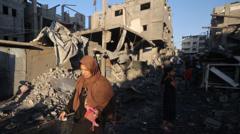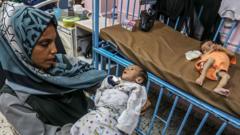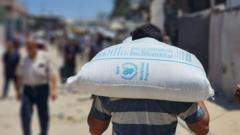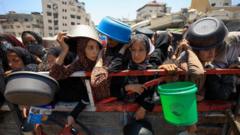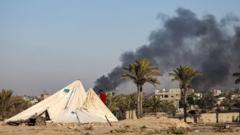The Gaza Humanitarian Foundation (GHF) is providing food aid to millions amid a growing starvation crisis. However, experts express serious concerns about the nutritional value of these boxes, which primarily contain dried foods. While the GHF claims the boxes provide sufficient calories, critics argue they fall short in essential vitamins and minerals, potentially leading to long-term health issues for recipients.
Inside Gaza's GHF Food Aid: What’s Really in the Boxes?
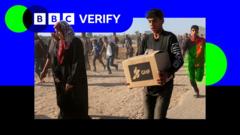
Inside Gaza's GHF Food Aid: What’s Really in the Boxes?
As malnutrition escalates in Gaza, the GHF distributes food boxes, but concerns arise over their nutritional adequacy.
In Gaza, over two million individuals are grappling with a starvation crisis, as reported by the United Nations, with rising cases of death due to malnutrition. The Gaza Humanitarian Foundation (GHF), supported by the US and Israel, has been active in the region since late May, claiming to have distributed approximately 91 million meals through food boxes.
Photos and details of the contents in these boxes have been limited, as international journalists cannot access Gaza. However, BBC Verify has reviewed images and spoken with aid experts expressing concerns about the nutritional content. The GHF has only released images recently, showing mainly dried foods that require water and fuel for preparation, such as pasta, chickpeas, lentils, and wheat flour, alongside cooking oil, salt, and tahini. Some ready-to-eat items, like halva bars, are also included.
The provided benchmark list claims that each box contains 42,500 calories, enough to feed 5.5 people for 3.5 days. Occasionally, substitutions such as tea and biscuits are included, with fresh items like potatoes and onions delivered separately.
Prof. Stuart Gordon from the London School of Economics assessed the nutritional value of GHF's food boxes, labeling them as having "serious weaknesses." He notes that while the boxes can ward off immediate hunger, the lack of essential nutrients could lead to "hidden hunger," increasing risks of health issues like anaemia. Dr. Andrew Seal from University College London echoed these concerns, highlighting deficiencies in calcium, iron, zinc, and several vitamins, and noted the absence of suitable foods for children.
Unlike the GHF, established agencies like the UN supply food in bulk while providing targeted nutrition for the most vulnerable populations. The World Food Programme (WFP) emphasizes the importance of nutritious emergency supplies for young children and pregnant women. Requests for nutritional guidance feedback from the GHF have not been answered.
Moreover, those receiving the boxes face significant challenges since cooking requires water and fuel, which are scarce due to the ongoing crisis. Recent warnings from the UN's Office of Humanitarian Affairs indicate that Gaza's water situation is rapidly worsening, with families resorting to unsafe cooking methods. The WFP reported a steep rise in prices of cooking gas on the black market—a staggering 4,000% increase.
As the situation deteriorates, UN Secretary-General António Guterres reported that malnutrition levels are soaring, with nearly one-third of Gaza's population going days without food. The WFP highlighted that around 90,000 women and children urgently need treatment due to severe malnutrition. The pressing questions arise regarding the adequacy and safety of the food aid being delivered and whether it complies with the urgent nutritional needs of those suffering in Gaza.
Photos and details of the contents in these boxes have been limited, as international journalists cannot access Gaza. However, BBC Verify has reviewed images and spoken with aid experts expressing concerns about the nutritional content. The GHF has only released images recently, showing mainly dried foods that require water and fuel for preparation, such as pasta, chickpeas, lentils, and wheat flour, alongside cooking oil, salt, and tahini. Some ready-to-eat items, like halva bars, are also included.
The provided benchmark list claims that each box contains 42,500 calories, enough to feed 5.5 people for 3.5 days. Occasionally, substitutions such as tea and biscuits are included, with fresh items like potatoes and onions delivered separately.
Prof. Stuart Gordon from the London School of Economics assessed the nutritional value of GHF's food boxes, labeling them as having "serious weaknesses." He notes that while the boxes can ward off immediate hunger, the lack of essential nutrients could lead to "hidden hunger," increasing risks of health issues like anaemia. Dr. Andrew Seal from University College London echoed these concerns, highlighting deficiencies in calcium, iron, zinc, and several vitamins, and noted the absence of suitable foods for children.
Unlike the GHF, established agencies like the UN supply food in bulk while providing targeted nutrition for the most vulnerable populations. The World Food Programme (WFP) emphasizes the importance of nutritious emergency supplies for young children and pregnant women. Requests for nutritional guidance feedback from the GHF have not been answered.
Moreover, those receiving the boxes face significant challenges since cooking requires water and fuel, which are scarce due to the ongoing crisis. Recent warnings from the UN's Office of Humanitarian Affairs indicate that Gaza's water situation is rapidly worsening, with families resorting to unsafe cooking methods. The WFP reported a steep rise in prices of cooking gas on the black market—a staggering 4,000% increase.
As the situation deteriorates, UN Secretary-General António Guterres reported that malnutrition levels are soaring, with nearly one-third of Gaza's population going days without food. The WFP highlighted that around 90,000 women and children urgently need treatment due to severe malnutrition. The pressing questions arise regarding the adequacy and safety of the food aid being delivered and whether it complies with the urgent nutritional needs of those suffering in Gaza.





